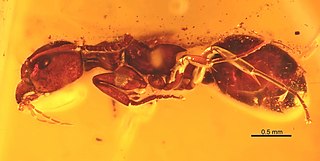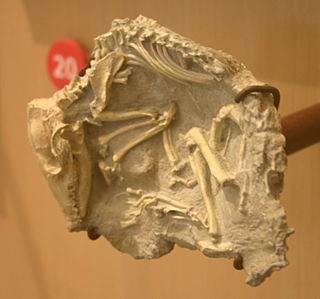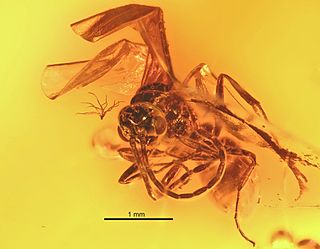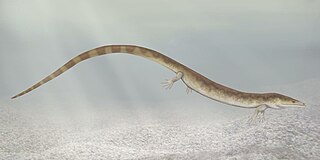 W
WAgroecomyrmex is an extinct genus of ants in the formicid subfamily Agroecomyrmecinae, for which it is the type genus. The genus contains a single described species, Agroecomyrmex duisburgi. Agroecomyrmex is known from a group of Middle Eocene fossils which were found in Europe.
 W
WAldabrachelys abrupta, the abrupt giant tortoise, is an extinct species of giant tortoise that was endemic to Madagascar.
 W
WAldabrachelys grandidieri, or Grandidier's giant tortoise, is an extinct species of tortoise that was endemic to Madagascar. Mitochondrial DNA extracted from subfossil bone confirm that it is a distinct species.
 W
WAphaenogaster sommerfeldti is an extinct species of ant in the subfamily Myrmicinae known from a group of Middle Eocene fossils found in Europe. A. sommerfeldti is one of three species in the ant genus Aphaenogaster to have been noted from fossils found in Baltic amber by William Morton Wheeler.
 W
WAublysodon is a genus of carnivorous dinosaurs known only from the Judith River Formation in Montana, which has been dated to the late Campanian age of the late Cretaceous period. The only currently recognized species, Aublysodon mirandus, was named by paleontologist Joseph Leidy in 1868. It is now considered dubious, because the type specimen consists only of an isolated premaxillary (front) tooth. Although this specimen is now lost, similar teeth have been found in many US states, western Canada, and Asia. These teeth almost certainly belong to juvenile tyrannosaurine tyrannosaurids, but most have not been identified to species level. However, it is likely that the type tooth belongs to one of the species in the genus Daspletosaurus, which was present in contemporary formations, and which matches specific details of the original tooth. The synapomorphies alleged to distinguish the Aublysodontinae, especially lack of serrations on premaxillary teeth could have been caused by tooth wear in life, postmortem abrasion, or digestion. Most other "aublysodontine"-type teeth may be from ontogenetic stages or sexual morphs of other tyrannosaurids.
 W
WChelydropsis is an extinct genus in the family of snapping turtle that lived from the Oligocene to the Pliocene in Asia and Europe.
 W
WCtenobethylus is an extinct genus of ants in the subfamily Dolichoderinae. The genus contains a single described species Ctenobethylus goepperti, where the fossil is known to be from the Baltic Amber. The fossil contained a preserved mesostigmatid mite attached to the head of the ant, which is perhaps the oldest known evidence of ecological association between mites and ants.
 W
WDinichthys herzeri is an extinct, giant, marine arthrodire placoderm from the Late Devonian of Ohio and Tennessee. It was comparable in size, shape, and ecological role to the better-known Dunkleosteus. Originally described in 1868 by John Newberry on the basis of an incomplete skull roof and mandibles, this species remains imperfectly known to this day.
 W
WDiplotomodon is a dubious genus of theropod dinosaur, from New Jersey. It was possibly a member of the Tyrannosauroidea, the clade that also contains Tyrannosaurus.
 W
WDolichoderus balticus is an extinct species of Eocene ant in the genus Dolichoderus. Described by Mayr in 1868, the fossils of a worker, queen and male of the species were discovered in the Baltic Amber.
 W
WDolichoderus cornutus is an extinct species of Eocene ant in the genus Dolichoderus. Described by Mayr in 1868, the fossils were discovered in the Baltic amber, where a fossilised worker ant was only described, and it is presumed these ants existed at least 40 million years ago.
 W
WDolichoderus longipennis is an extinct species of Eocene ant in the genus Dolichoderus. Described by Mayr in 1868, the fossils were discovered in the Baltic Amber.
 W
WDolichoderus sculpturatus is an extinct species of ant in the genus Dolichoderus. Described by Mayr in 1868, a fossilised worker was discovered and described in the Baltic amber.
 W
WDolichoderus tertiarius is an extinct species of Eocene ant in the genus Dolichoderus. Described by Mayr in 1868, fossils of a worker, queen and male were discovered and described in the Baltic amber.
 W
WElasmosaurus (;) is a genus of plesiosaur that lived in North America during the Campanian stage of the Late Cretaceous period, about 80.5 million years ago. The first specimen was discovered in 1867 near Fort Wallace, Kansas, US, and was sent to the American paleontologist Edward Drinker Cope, who named it E. platyurus in 1868. The generic name means "thin-plate reptile", and the specific name means "flat-tailed". Cope originally reconstructed the skeleton of Elasmosaurus with the skull at the end of the tail, an error which was made light of by the paleontologist Othniel Charles Marsh, and became part of their "Bone Wars" rivalry. Only one incomplete Elasmosaurus skeleton is definitely known, consisting of a fragmentary skull, the spine, and the pectoral and pelvic girdles, and a single species is recognized today; other species are now considered invalid or have been moved to other genera.
 W
WEucladoceros or bush-antlered deer is an extinct genus of deer whose fossils have been discovered in Europe, the Middle East and Central Asia. This genus was formally described by Hugh Falconer in 1868.
 W
WThe European dhole was a paleosubspecies of the dhole which ranged throughout much of Western and Central Europe during the Middle and Late Pleistocene. Like the modern Asiatic populations, it was a more progressive form than other prehistoric members of the genus Cuon, having transformed its lower molar tooth into a single cusped slicer. It was virtually indistinguishable from its modern counterpart, save for its greater size, which closely approached that of the gray wolf.
 W
WLeptictis is an extinct genus of mammal. It was related to the better-known Leptictidium.
 W
WThe ground sloths of the extinct genus Megalocnus were among the largest of the Caribbean ground sloths, with individuals estimated to have weighed up to 90 kg (200 lb) when alive. Two species have been described, M. rodens of Cuba, and M. zile of Hispaniola. Their relatives include other Caribbean ground sloths, such as Acratocnus, Mesocnus, Miocnus, Neocnus, Parocnus, and Paulocnus. M. zile is currently thought to be a junior synonym of Parocnus serus.
 W
WOestocephalus is an extinct genus of aïstopod lepospondyl that lived during the Carboniferous period. Fossils have been found in the Czech Republic, and in Ohio and Illinois in the United States. It is the type genus of the family Oestocephalidae, although it used to be assigned to the family Ophiderpetontidae, which is now considered paraphyletic. It was named by Edward Drinker Cope in 1868 and now contains two species, O. amphiuminus and O. nanum.
 W
WOsteopygis is a genus of extinct turtle. Osteopygis, as traditionally seen, is a chimera: the postcrania belong to a non-marine stem-cryptodire, whilst the crania belong to sea turtles. In 2005 the referred material was split between two taxa: the postcrania remained in Osteopygis, while the crania were reassigned to Euclastes wielandi.
 W
WPachycondyla succinea is an extinct species of ant in the formicid subfamily Ponerinae described from fossils found in Europe. P. petrosa is one of three middle Eocene Pachycondyla species found in Baltic amber.
 W
WPrionomyrmex is an extinct genus of bulldog ants in the subfamily Myrmeciinae of the family Formicidae. It was first described by Gustav Mayr in 1868, after he collected a holotype worker of P. longiceps in Baltic amber. Three species are currently described, characterised by their long mandibles, slender bodies and large size. These ants are known from the Eocene and Late Oligocene, with fossil specimens only found around Europe. It is suggested that these ants preferred to live in jungles, with one species assumed to be an arboreal nesting species. These ants had a powerful stinger that was used to subdue prey. In 2000, it was suggested by Cesare Baroni Urbani that the living species Nothomyrmecia macrops and a species he described both belonged to Prionomyrmex, but this proposal has not been widely accepted by the entomological community. Instead, scientists still classify the two genera distinctive from each other, making Nothomyrmecia a valid genus.
 W
WPristerodon is an extinct genus of dicynodont therapsid from the Late Permian of South Africa, Zambia and India.
 W
WRhynchotherium is an extinct genus of proboscidea endemic to North America and Central America during the Miocene through Pliocene from 13.650—3.6 Ma, living for approximately 10 million years .
 W
WSauropleura is an extinct genus of nectridean lepospondyls within the family Urocordylidae. Fossils are known from the United States and Europe. The following species are included:Sauropleura bairdi Sauropleura longicaudata Sauropleura pectinata Sauropleura scalaris
 W
WYantaromyrmex is an extinct genus of ants first described in 2013. Members of this genus are in the subfamily Dolichoderinae of the family Formicidae, known from Middle Eocene to Early Oligocene fossils found in Europe. The genus currently contains five described species, Y. constrictus, Y. geinitzi, Y. intermedius, Y. mayrianum and Y. samlandicus. The first specimens were collected in 1868 and studied by Austrian entomologist Gustav Mayr, who originally placed the fossils in other ant genera until the fossils were reviewed and subsequently placed into their own genus. These ants are small, measuring from 4 to 6 mm in length and can be characterized by their trapezoidal shaped head-capsules and oval compound eyes that are located slightly to the rear of the capsules midpoint, with no known ocelli present.